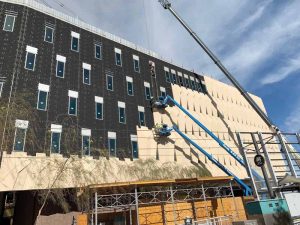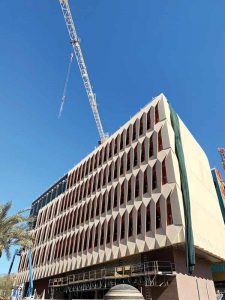
New options for open-joint systems give even greater design flexibility
In most open-joint systems, the small gaps in the cladding will not be visible from a distance. However, where gaps are more pronounced, or when the architect wants to ensure a clean and consistent look, stone wool insulation boards are now available with an integral facing of bonded black matte fleece, leaving the appearance of crisp, black lines. The fleece is a glass fiber tissue with a black organic mineral coating and is chemically bonded to the insulation during the manufacturing process, offering better mechanical properties and superior long-term performance. It can withstand long-term ultraviolet (UV) exposure with no significant loss of depth in color.
Previously, to achieve the same look, the only option was to include an additional layer to the assembly. Many cladding component manufacturers have added this type of separate facer to their portfolios, but installation and materials for the additional layer tend to be more costly and labor intensive than the use of a single product with an integral facing.
ASU’s Interdisciplinary Science and Technology Building 7
Specialty commercial contractor MKB Construction in Tempe, Arizona, brought this new fleece-faced insulation board solution to the attention of the general contractors building the new Interdisciplinary Science and Technology Building 7 at Arizona State University (ASU). Project manager Cameron Geske recognized the opportunity it would provide to the building’s designers; they were challenged with a facade that reflects innovation, which is central to the new research center in its visual design, without sacrificing the performance required from various assemblies to support the sustainability goals.
The facade is a unique geometric system of overlapping glass fiber reinforced concrete (GFRC) panels with open joints, installed over the backup wall behind it. It would be necessary to design this open-joint assembly in such a way as to ensure the performance of the building’s envelope, while being exposed to the elements—all while maintaining its aesthetic appeal.
The matte black fleece-faced rigid stone wool insulation board was eventually specified after other approaches, including an insulated metal panel system, failed to meet the unique challenges presented by this design for an open-joint facade.
“This solution fit the bill for so many reasons,” says Geske. “We had worked with stone wool insulation on past projects and knew it would meet our needs for consistent R-value and superior thermal performance, as well as its fire-resistant and sound insulation properties.”

The rigid stone wool boards used as exterior ci are also frequently recommended by contractors such as Geske because they are relatively easy to install. The matte black fleece-faced option went even further, as Geske’s team was able to install it under the open-joint cladding, knowing it would not be damaged by exposure to rain and UV light. Building on the features and benefits of the original insulation boards, the matte black fleece-faced option also offered the project’s architects and builders the clean visual aesthetic they wanted in the open-joint system.
“No one wants to see the insulation through the seams in the facade,” adds Geske. “The thin black facer on the insulation boards meant we did not need to apply another layer to cover up the board; it was an efficient and effective solution.”




